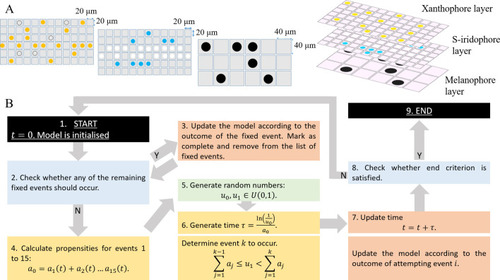|
Model setup and simulation.(A) An example model setup. The domain is made up of three layers. Layer 𝑿 which contains yellow X (yellow circles) and unpigmented Xb (clear circles with black outline). Layer 𝑰 which contains silvery Id (white circles) and blue Il (blue circles). Layer 𝑴 which contains black M (black circles) only. Each lattice site on each of the respective layers contain at most one cell at any given time. The layers are stacked on top of each other as seen in real fish. We note that in our simulations the ordering of the layers does not play any role in determining pattern formation. (B) Schematics of model implementation. (1) The model is initialised as described in Appendix 1. (2) The model is checked for the requirements for a fixed event to occur (e.g. new cells differentiating at a given time). If there is a fixed event to be implemented, the algorithm moves to stage 3. Otherwise, the algorithm passes to stage 4. (3) The model is updated according to the fixed event and algorithm returns to stage 2. (4) The propensity functions - probabilities for all other events to occur α1(t),…α15(t) are calculated. (5) Random numbers u0,u1∈U(0,1) are generated. (6) Numbers u0,u1 are used to determine the time τ until the next event and which event will be implemented. (7) The model configuration is updated. (8) The algorithm checks if the end criterion is satisfied, that is in the case of WT, that ΩSL=13.5mm. If so, the algorithm finishes. Otherwise the algorithm continues, returning to stage 2. (9) The simulation completes.
|

